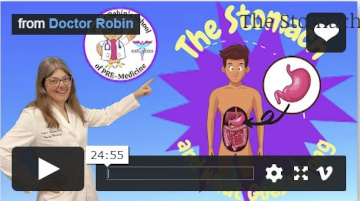Dr. Robin’s School of Pre-Medicine can provide a significant amount of course content on human anatomy, but it serves best as supplemental material. The website says that it was created for children in grades three through eight and can also be used as a supplement for older students.
The Videos
The course material is presented on videos labeled either beginner or intermediate. Most of the beginner videos seem best for students in grades four through eight. I think the intermediate videos are most suitable for students in sixth grade through high school, although younger students who want to learn more can certainly benefit from them. Dr. Robin's School includes either a coloring page or a worksheet for each video.
The videos are grouped under headings such as Microbiology, Eight Senses, Pulmonology: Lungs, Neurology: Nerves & Brain, and Genetics & DNA. Subscribers have access to all content—they just select a topic then choose a video. The videos are arranged in order of increasing difficulty.
Some of the videos listed under the topics also show up under two special headings that identify the videos offering students hands-on activities. Under “Drawing, Coloring, Modeling,” five videos labeled for beginners have students either draw on their own or color a downloadable, PDF coloring page. Two lessons for the intermediate level have students work with modeling clay—in one instance, to make a model of the heart and its blood vessels.
Under “Dissections, Activities, & Experiments,” there are four videos with hands-on activities for beginners. For the intermediate level, there are six videos with hands-on activities plus two dissections (a beef heart and a chicken).
Most videos run about a half an hour. However, there are a few outliers. One hands-on activity is less than eight minutes long, and the chicken dissection runs almost 50 minutes.
Dr. Robin often begins the videos with analogies that will help students understand concepts. For instance, early in the beginner video, “Draw a Human Cell,” she discusses in detail the process of baking cookies and draws an analogy to the cell’s production of proteins to explain how all of the components in the cell work. She sometimes uses visual aids or illustrations, but the videos are primarily of Dr. Robin teaching. She is an excellent teacher, and these videos rely much more on her presentation skills than on graphics or other elements.
Even the beginner videos have a significant amount of content. For example, in the beginner video “Blood & Blood Components,” Dr. Robin discusses the blood’s role in carrying oxygen, removing carbon dioxide, transporting nutrients throughout the body, removing waste products, and serving as part of the immune system. She uses accurate terms such as nutrients, electrolytes, carbon dioxide, platelets, neutrophils, and granulocytes. While the vocabulary is challenging for younger students, they do not have to actually learn it. Nevertheless, students who watch these videos can learn a great deal.
As of October 2021, there are 32 beginner- and 28 intermediate-level videos. New videos are being added regularly.
Summary
The videos do a good job of conveying information in a manner understandable for students below high school level, and they are likely to be more effective than textbooks for most children.









